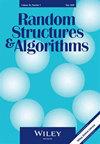随机正则图的谱隙
IF 0.8
3区 数学
Q4 COMPUTER SCIENCE, SOFTWARE ENGINEERING
引用次数: 5
摘要
我们使用一种基于傅里叶分析的新方法,对随机d $$ d $$‐正则图的第二个特征值进行了绑定,用于大范围的d $$ d $$度。设Gn,d $$ {G}_{n,d} $$为n $$ n $$个顶点上的一致随机图形$$ d $$‐正则图,λ(Gn,d) $$ \lambda \left({G}_{n,d}\right) $$为其绝对值第二大特征值。对于某常数c>0 $$ c>0 $$和任意阶d $$ d $$且log10n≪d≤cn $$ {\log}^{10}n\ll d\le cn $$,我们几乎可以肯定地证明λ(Gn,d)=(2+o(1))d(n−d)/n $$ \lambda \left({G}_{n,d}\right)=\left(2+o(1)\right)\sqrt{d\left(n-d\right)/n} $$。结合先前涵盖稀疏随机图情况的结果,这完全确定了对于所有d≤cn $$ d\le cn $$ λ(Gn,d) $$ \lambda \left({G}_{n,d}\right) $$的渐近值。为了实现这一目标,我们引入了使用离散傅立叶分析机制的新方法,并将它们与d $$ d $$ -正则随机图(特别是Liebenau和Wormald的随机图)上的现有工具和估计相结合。本文章由计算机程序翻译,如有差异,请以英文原文为准。
The spectral gap of random regular graphs
We bound the second eigenvalue of random d$$ d $$ ‐regular graphs, for a wide range of degrees d$$ d $$ , using a novel approach based on Fourier analysis. Let Gn,d$$ {G}_{n,d} $$ be a uniform random d$$ d $$ ‐regular graph on n$$ n $$ vertices, and λ(Gn,d)$$ \lambda \left({G}_{n,d}\right) $$ be its second largest eigenvalue by absolute value. For some constant c>0$$ c>0 $$ and any degree d$$ d $$ with log10n≪d≤cn$$ {\log}^{10}n\ll d\le cn $$ , we show that λ(Gn,d)=(2+o(1))d(n−d)/n$$ \lambda \left({G}_{n,d}\right)=\left(2+o(1)\right)\sqrt{d\left(n-d\right)/n} $$ asymptotically almost surely. Combined with earlier results that cover the case of sparse random graphs, this fully determines the asymptotic value of λ(Gn,d)$$ \lambda \left({G}_{n,d}\right) $$ for all d≤cn$$ d\le cn $$ . To achieve this, we introduce new methods that use mechanisms from discrete Fourier analysis, and combine them with existing tools and estimates on d$$ d $$ ‐regular random graphs—especially those of Liebenau and Wormald.
求助全文
通过发布文献求助,成功后即可免费获取论文全文。
去求助
来源期刊

Random Structures & Algorithms
数学-计算机:软件工程
CiteScore
2.50
自引率
10.00%
发文量
56
审稿时长
>12 weeks
期刊介绍:
It is the aim of this journal to meet two main objectives: to cover the latest research on discrete random structures, and to present applications of such research to problems in combinatorics and computer science. The goal is to provide a natural home for a significant body of current research, and a useful forum for ideas on future studies in randomness.
Results concerning random graphs, hypergraphs, matroids, trees, mappings, permutations, matrices, sets and orders, as well as stochastic graph processes and networks are presented with particular emphasis on the use of probabilistic methods in combinatorics as developed by Paul Erdõs. The journal focuses on probabilistic algorithms, average case analysis of deterministic algorithms, and applications of probabilistic methods to cryptography, data structures, searching and sorting. The journal also devotes space to such areas of probability theory as percolation, random walks and combinatorial aspects of probability.
 求助内容:
求助内容: 应助结果提醒方式:
应助结果提醒方式:


